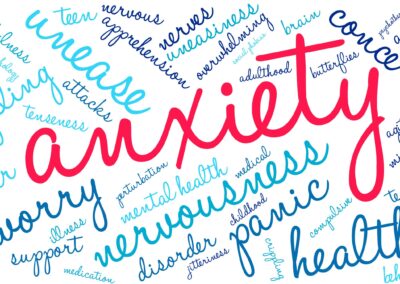Anxiety disorders are one of the most common mental health conditions, approaching 300M people affected worldwide, including more than 40 million American adults each year. Anxiety disorders can be crippling, preventing individuals from carrying out everyday tasks and functioning normally. Those who suffer from anxiety disorders can experience overwhelming fear, worry, and panic that interferes with their lives. Anxiety disorders can be divided into four major types: generalized anxiety disorder (GAD), social anxiety disorder, panic disorder, and specific phobias. Below is a brief overview of each.
Generalized Anxiety Disorder (GAD)
Generalized anxiety disorder (GAD) affects over 6.8 million adults in the United States and often co-occurs with major depression. Sufferers of GAD experience persistent, excessive, and unrealistic worry about everyday life activities and events. This worry is often accompanied by physical symptoms such as restlessness, fatigue, difficulty concentrating, muscle tension, and irritability. People with GAD often expect the worst and experience difficulty managing their worries.
Social Anxiety Disorder
Social anxiety disorder is characterized by an intense fear of being judged or scrutinized by others, which can lead to extreme self-consciousness in everyday social situations. People with social anxiety disorder may experience physical symptoms such as blushing, sweating, trembling, nausea, and difficulty speaking. Social anxiety disorder is estimated to affect over 15 million adults in the United States.
Panic Disorder
Panic disorder is characterized by recurrent, unexpected panic attacks. These episodes are sudden surges of intense fear or discomfort that come on quickly and reach peak intensity within minutes. During a panic attack, people may experience a variety of physical symptoms such as chest pain, feeling faint, sweating, trembling, and difficulty breathing. Panic disorder is estimated to affect over 6 million adults in the United States.
Specific Phobias
Specific phobias are intense and irrational fears of specific objects or situations. Common phobias include fear of flying, fear of driving, fear of heights, fear of enclosed spaces, fear of animals, and fear of needles. People with specific phobias often experience physical symptoms such as increased heart rate, sweating, trembling, and difficulty breathing when confronted with the feared object or situation. Specific phobias are estimated to affect over 19 million adults in the United States.
Treatments for Anxiety
It is important to note that anxiety can be a difficult disorder to manage. That said there are numerous conventional treatment approaches. One of the most common treatments for anxiety is psychotherapy, which can help individuals to identify the root cause of their anxiety and learn coping strategies. Cognitive-behavioral therapy (CBT) is one of the most effective forms of psychotherapy, as it helps individuals to challenge negative thoughts and behaviors, as well as develop new skills to manage stress . Additionally, medication can be prescribed to help manage the symptoms of anxiety, such as selective serotonin reuptake inhibitors (SSRIs), serotonin-norepinephrine reuptake inhibitors (SNRIs), and benzodiazepines. Anxiety can also be managed with lifestyle changes, such as exercising regularly, getting enough sleep, eating a healthy diet, and practicing mindfulness and relaxation techniques.
Addressing the root cause of anxiety should be the ultimate goal and although traditional treatment approaches are proven effective they also take time to develop, along with effort and consistency from you. During the process, side effects of anxiety will be present and can lead to daily life disruptions. Sometimes, something as simple as breathing can go a long way toward reducing anxiety and improving mental health. That’s why Muvik Labs developed BreathConductor™ .
Breathing plays a significant role in control of the autonomic nervous system (ANS) which governs subconscious aspects of the body and mind. The ANS is composed of two branches, sympathetic, which controls the stress response (Think Fight or Flight) and parasympathetic, which controls the relaxation response (Think Balanced and Relaxed). BreathConductor™ utilizes a multisensory combination of specifically designed evidenced-based music, paced diaphragmatic breathing, and timed visual imagery to entrain the connection between the heart and brain which rebalances the ANS, thus lowering your heart rate and blood pressure, while increasing your heart rate variability (HRV), and returning you to a relaxed state.
Our proven, evidence-based, real world tested program works on three levels: mental, emotional, and physical. By using simple, easy-to-follow exercises, BreathConductor(™ helps individuals learn to recognize, manage, and reduce anxiety symptoms, within moments. With consistent use it also assists individuals build healthy coping skills.
Overall, anxiety is a major mental health crisis that affects millions of people around the world. It is important to be aware of the causes, symptoms, and treatments of anxiety in order to help those affected. With the right support and treatment, individuals can learn to manage their anxiety and live a healthier and happier life.
BreathConductor™ can be used independently or in concert with your anxiety treatment plan to reduce stress, improve sleep, and manage your well-being.
To learn more, on how BreathConductor™ can assist you, or your team Contact Us here at [email protected].




